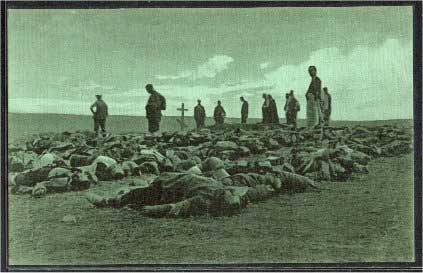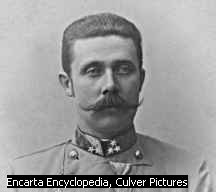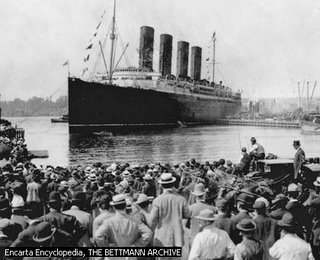Siddharth's Mordern History Blog
The 1910s : The Age of Improvement, Colonization, and Technology
The Sinking of the Titanic
 Titanic
TitanicThe Titanic was a British passenger ship believed by experts to be unsinkable until it struck an iceberg April 14, 1912, about 153 km (about 95 mi) south of Newfoundland, and sank early the next morning. The loss of the Titanic during its maiden voyage is considered one of the worst disasters in history. Of the more than 2200 passengers and crew on board, over 1500 died.
One of the most important events that occurred in the 1910s is the sinking of the Titanic. Titanic set off its voyage which occupied approximately 2220 passengers in 1912. It was headed towards New York City giving it the best speed to push forward when it struck an iceberg. The Titanic which was considered unsinkable sank in less 3 hours sinking 2220 passengers in the cold waters of the oceans.
The Balkan Wars (1912-1913) Another big event in the 1900s are the Balkan Wars which started out small but ended as a big event. Many people thought that this war was going to be a very big war and indeed that was what happened. The attack was on Turkish people that were taking control of the Balkan regoin. Nationalism flared up this war. Serbia, Romania, Bulgaria had fought in this war and got huge amounts of land from the Turks. Then later on, they fought among themeselves to take more land. This results in a good way for the Serbians. When the Serbians finally came out of the war, they were seen to be a more stroger Serbian nation.
Another big event in the 1900s are the Balkan Wars which started out small but ended as a big event. Many people thought that this war was going to be a very big war and indeed that was what happened. The attack was on Turkish people that were taking control of the Balkan regoin. Nationalism flared up this war. Serbia, Romania, Bulgaria had fought in this war and got huge amounts of land from the Turks. Then later on, they fought among themeselves to take more land. This results in a good way for the Serbians. When the Serbians finally came out of the war, they were seen to be a more stroger Serbian nation.
World War I
A big event that has taken many people's lives was the World War I. This war resulted because of several reasons. First of all, the Serbians rose out to be a powerful yet small nation. This increased the fear of Austria- Hungarian people. Finally, an Archduke went to visit the regoin of Bosnia where he was murdered by a terrorist group called "Black Hand". The Serian government was blamed for it, and the Austria- Hungarian government wanted an apology for killing the next emperor in line for Austria-Hungary. The Serbian government said that it wasn't there fault that the Archduke was killed, and they didn't apologize. Austria-Hungary called war on Serbia. Serbia was backed up by Russia while Germany was behind Austria- Hungary. France and Britain also joined in the war. No government could control the war. The countries just seemed to be dragged into it by the urge to win a war and defeat Germany. A total of 65 million people were assembled to fight the war, 9 million were killed and 22 million were injured. This war indeed caused a lot of damage.  Paris Peace Conference
Paris Peace Conference
When Germany was finally defeated in world War I, the other groups found it amazing at how much Germany has to pay for the reparations of the war. So, leaders from United States, Britain, France, and Italy met at the Paris Peace Conference in 1919 and drafted the Treaty of Versailles. This treaty said that Germany has to pay for al the reparations. Germany was also forbidden to do a number of things. Representatives at the conference included, left to right, British prime minister Lloyd George, Italian foreign minister Giorgio Sonnino, French premier Georges Clemenceau, and U.S. president Woodrow Wilson.
Important people of the Decade (3)
Francis Ferdinand
 Francis Ferdinand
Francis Ferdinand
The assassination of Francis hit pretty hard on the Austrian government since he was the next-in-line to be the king, and that was part of why the World War I flared up. Both Francis and his wife were killed by a Serbian nationalist Gavrilo Princip in Sarajevo, Bosnia.
Francis Ferdinand was the archduke of Austria, the next in line emperor to Austria-Hungary. He was born in Graz, and was the son of Archduke Charles Louis. After the death of his cousin Crown Prince in 1889 and that of his father’s in 1896, Franz became the heir to the Austria- Hungarian crown. Francis was really interested in the goal that the Serbians had made, and how strogly they had fought in the Balkan Wars and came out as a powerful nation. Unfortunately, he and his wife went on a visit to Sarajevo, Bosnia. The driver took a wrong turn and the Archduke and his wife were killed then and there on June 28, 1914 by a terrotist group named “Black Hand”. This incident was the trigger that caused the World War I.
Vladimir Ilich Lenin
 Lenin Addresses Crowd in 1917
Lenin Addresses Crowd in 1917
Lenin led the Bolshevik revolt that led him to take over the Russian government in what was known as the October Revolution of 1917. When he came in power, he sent delegates to negotiate with the Germans and take themselves out of World War I. Russia and Germany signed the Treaty of Brest-Litovsk in March 1918 which gave Germany huge amount of land.
He was a Russian revolutionary leader who became the first president of Soviet Russia and then of USSR. He was the leader of the Bolshevik Party that was named the Communist Party later on. This shows that he believed in communism. Bolshevik Party seized power of the Russian Revolution in 1917. Vladimir Ilich Lenin hated the way the government was formed in Russia. He then became the leader of the USSR in 1922. Lenin held his power until the end of his life in 1924. He had the highest post until he died. After him, Joseph Stalin assumed power.
Eleutherios Venizelos
 Eleutherios Venizelos
Eleutherios Venizelos
In 1917, he became the Prime minister of Greece. Under his command, Greece joined the allies and actively took part in demolishing German efforts to win.
Eleutherios Venizelos was born in Crete and was educated at the University of Athens. He was a Greek statesman and diplomat. He had participated in the revolt against the Turkish rule. He had also presided the government of Crete between 1898 and 1910. In 1910, he was the prime minister of Greece. He had also guided his country through the Balkan Wars. When he wasn’t there during the World War I, Constantine I had become the king of Greece and taken over. However, Eleutherios Venizelos took control again in 1917 and went to help the Allied countries. When the time of election came again, Eleutherios Venizelos had lost by many votes until 1928 when he came back to power an dbecame the prime minister for 4-year term. When he was finally the prime minister again, he led an unsuccessful revolt in Crete and then he was forced to exile in 1935.
Important Technological Improvement of the Decade (2)
In 1911, W.H. Carrier first came up with the air-conditioner. He was an American. It was an important invention as we might get to see today. In each classroom of our school, there are about 3 air-conditioners. People find it impossible to stay somewhere without it.
Another invention was brought up by Casimir Funk in the 1911. He was a Polish. He came up with Vitamins. If it wasn’t for him, the navy wouldn’t have survived. There was this disease called cramps. So thank to him that the navy in those days didn’t suffer a lot.
Again in 1911, Jacques Edwin Brandenberger came up with Cellophane. He was a Swiss. Cellophane is a very flexible substance made from cellulose. It is used as a wrapping material. It is a transparent film. He also invented the first machines that produced and manufactured Cellophane in large scales.
In 1911, Neon Lamp was also invented by Georges Claude. He was French. Although we might think that a neon lamp isn’t so important to us nowadays but it really made a big deal for them in those days. Before the incandescent lamp, the Argand burner was used. In places where gas supply was unavailable lamps that used oil from the reservoir was still in use. Whale oil was the chief fuel for such lamps until about the middle of the 19th century.
In the 1913, René Lorin of France came up with the Ramjet engine. This was a really big step towards war flights since the ramjet engine gave really high speeds. That was the biggest of the advantages. The ramjet engine was also one of the first engines used.
In 1913, gasoline was invented by William Meriam Burton who was an American. It is defiantly one of the most important inventions since it gave way to the energy of the modern vehicles making them more efficient.
A radio receiver was invented by Reginald Aubrey Fessenden in 1913. He was an American. A radio receiver in those days meant not only for entertainment but also for the use of exchanging information.
Then in 1915, an automatic rifle or sometimes called the Browning gun was invented by John Moses Browning. He was also an American. Browning efficient gun advanced the use of technology in wars. He had made the gun to be light and efficient releasing speedy bullets. It was used in the First World War and also in the Second World War. It was also used in the Korean War. The amazing fact is that, we still find its uses in our modern world. That is how history still affects us.
 Browning M2 Machine Gun
Browning M2 Machine GunThe Browning M2 .50-caliber heavy machine gun stores linked bullets in the box near the middle of the gun. Empty shells are ejected from the other side of the gun as the Browing machine gun fires. M2 machine guns can be fired from tripods on the ground, or mounted on vehicles for an increase in movement.
In 1916, X-ray tube was invented by William David Coolidge. He was an American. He in fact, helps the modern times. Doctors today still use X-rays to identify broken bones, etc. Imagine how much it had helped the doctors in those days.
A Famous Art of the Decade
David and Goliath
A famous art in 1900s is known David and Goliath done by Arthur Kampf. This sculpture was started from 1905 and completed in 1915. This is a classically style painting that shows the difference in the strong and the weak yet the difference in their intelligence.
A Famous Musicain of the Decade
 Robert Leroy practising his daily singing and chorus unit.
Robert Leroy practising his daily singing and chorus unit.
Robert Leroy Johnson was born on May 8, 1911. He was known as the most famous Delta Blue musician. His songs and his guitar style compared to other musicains were extremely influential. People admired him very much. Robert had written and recorded a total of 29 songs. These are "Come on in My Kitchen", "Love in Vain", "Sweet Home Chicago", "Crossroads Blues", "Terraplane Blues", and "I Believe I'll Dust My Broom", were among to best and were later covered by other musicans. He had published the "Complete Recording" which has everything that Robert has recorded. That was released in 1910. There were many person that were influenced by his songs. They were Eric Clapton, Led Zeppelin , Bob Dylan , and John Hammond Jr. are only to name a few of these.
A Popular Consumer Product of the Decade 
Carbon Black
Carbon black is processed by the combustion of petroleum product. Carbon black is very similar to soot, a black colored substance. Carbon black is used as a pigment to produce rubber and plastic products. Carbon black is a harmful substance if inhaled. Ming Dynasty was one of the periods where carbon black was very common. Carbon black was one of the early substances that were used in the early 1900s as an agent in automobile tires and other rubber goods. In World War II, carbon black was used in silver materials.
A Famous book of the Decade
The Tale of Squirrel Nutkin is a children type of story written by Beatrix Potter in 1903. She won the hearts of many children. The stroy has a been famous for many years. The story follows like this. One day, Squrrel Nutkin goes with the other squirrels to collect nuts. He was playing and making mischief. They had to present it to the owl. Then Nutkin was skined alive from the tail. He had learned his lesson.
An Important Scietific Discovery of the Decade
In the 1900s, a big achievement was marked in the name of Thomas Alva Edison for coming up with the incandescent lamp. This first electric lamp that could be operated on wires was sold for $16-$24 in those days. It had a glass dome that was either the color of amber, green, or blue glass.
Some Pictures of the Decade
Map of the 1900s
As you can see from the map, that it is not completely accurate to what the world map today is like. There is Autria-Hungary, etc in this map that makes it different.
Working Women in World War I (1914-1918)
World War I had claimed many of the young people to go and fight the war. France had a shortage of workers in its factory. That is why women were put to work to fill in the gap for the men. Over here, the women are working in a bullet factory during the war.
 German U-Boat
German U-BoatSubmarines were used by the Germans in February 1915. These submarines were called U-boats. They were there to erase of any other ships that were against the Allies. Germany’s U-boats were very effective in wiping out Allied ships. They sank ships that were neutral also. But this had its own problems. It brought Americans into the World War.
 Lusitania
LusitaniaThis was a British ship that was departing from New York in 1915 when it got blown off by a German submarine. Germany claimed that British and America were going to attack Germany and that they carried arms. The ship sank in less than 20 minutes. It killed 1198 people. U.S.A got very angry when they were also blamed of carrying arms. So, they too joined the war. That was one of the main reasons that pulled America to the war.

Silver Ghost
In the 1910s, only the rich could afford this automobile. It was called the Rolls-Royce Silver Ghost which included 6 engines, leather from inside the car, folding windscreen, hood, and an aluminum body. This vehicle was driven by hired chauffeurs, but mostly the people were interested in showing off their style and the comfort on driving it rather than the emphasis in their speed.




